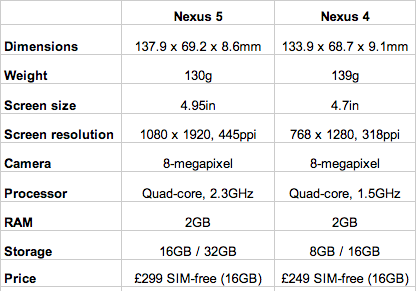Google Nexus 5 vs Nexus 4: Should I Upgrade?

After what feels like months of anticipation, rumours and false starts, the Google Nexus 5 is finally with us; here's how it compares to the year-old phone it replaces, the Nexus 4.
Nexus 5 vs Nexus 4: Hardware
At first glance, the Nexus 4 and Nexus 5 look similar, although the newer phone has a slightly larger screen, at 4.95in compared to the 4.7in Nexus 4. Resisting the urge to produce a 6in 'phablet' is a good move by Google and manufacturer LG in our book.
The display is protected by Gorilla Glass and surrounded by a generic-looking black bezel, but thanks to the bezel being more compact than with the Nexus 4, the newer phone has only a slightly larger footprint, while being half a millimetre thinner.
LG has reduced the Nexus' thickness from 9.1mm to 8.6mm, and the footprint has grown slightly from 134 x 69mm to 138 x 69mm. However the phone's weight has dropped from 139g to 130g, the same as the Samsung Galaxy S4.
Around the back, the phone no longer has the Nexus 4's unique, sparkling finish, instead opting for matte, black, rubberised plastic. Mirroring the recently updated Nexus 7 tablet, the new phone has a 'Nexus' logo written vertically across its back.

Nexus 5 vs Nexus 4: Display
As we've already said, the Nexus 5's screen is slightly larger than the Nexus 4's, but the real improvement comes with its resolution. The Nexus 5 gets a full HD resolution (1080 x 1920 pxiels) giving it a pixel density of 445 pixels per inch (ppi), compared with the 768 x 1280 resolution screen of the Nexus 4 which had a pixel density of 318ppi.
Nexus 5 vs Nexus 4: Camera
In reaching the low £299 price point, LG has had to make some compromises - chief among which is the Nexus 5's camera. As with the Nexus 4 last year, the 8-megapixel sensor is nothing to write home about when compared to some rivals, but the addition of optical image stabilisation will help to appease consumers who were expecting a Nokia Lumia 1020 rival for half the price.
As with last year's phone, the Nexus 5 can shoot 1080p HD video, and its front-facing camera is 1.3-megapixels.
Nexus 5 vs Nexus 4: 4G
A major omission from the original Nexus 4 was its lack of 4G support. Although this was less of a problem at launch, when in the UK only EE provided such a network, rivals O2 and Vodafone have now joined the party, making the Nexus 4 feel dated.
Thankfully, the Nexus 5 has support for all UK 4G networks, and at £299 it will be one of the most affordable 4G smartphones on the market.
Nexus 5 vs Nexus 4: Performance
Despite its bargain price of £239 SIM-free, the Nexus 4's performance was excellent, with the quad-core, 1.5GHz processor and 2GB of RAM easily capable of multitasking, HD video playback, intensive 3D gaming and more.
For the Nexus 5, Google and LG have used the popular Snapdragon 800 processor from Qualcomm, as used by the Samsung Galaxy S4, HTC One and Sony Xperia Z1. This means a quad-core, 2.3GHz clock speed with 2GB of RAM.
With regards to storage, Nexus 5 buyers can choose between either 16GB or 32GB - up from the option of 8GB and 16GB for the Nexus 4. Unfortunately, as was the case with the Nexus 4, the Nexus 5 does not have a microSD card slot, so storage cannot be increased.
Nexus 5 vs Nexus 4: Software
Google is using the Nexus 5 to debut its latest version of Android - 4.4 Kit Kat. The update includes an updated phone dialer, which can be used to search for local businsses by entering keywords; the dialer will also look up unknown incoming phone numbers and provide any potential matches it finds in Google's search results.
Nexus 5 vs Nexus 4: Price
The killer feature of the Nexus 4 is back for the Nexus 5 - its low price. At £299 (and £339 for the 32GB model), the phone is considerably cheaper than its rivals from Apple, Samsung and HTC, where £500 is par for the course. A lack of upgradable storage is a shame, and some heavy users will criticise the lack of a 64GB option compared to the iPhone 5s, but at this price we suggest they don't complain too loudly.
Should I upgrade?
Consumers have surely got used to evolution over revolution when it comes to annual smartphone updates, and sometimes it can be difficult to justify spending more than £500 on the latest iPhone or Samsung Galaxy - but given its low price, the same can't be said for the Nexus 5.
For a little over half the price of the cheapest iPhone 5s, Android fans get a new Nexus 5 with a much improved screen resolution, an industry-leading processor every bit as powerful as anything Samsung has to offer, 4G, and an improved camera.
Google and LG might not be able to bring aluminium and the premium feel of an iPhone to a sub-£300 price point, but the two companies have made just the right amount of compromises in all the right places, to maintain an impressive screen, processor and operating system.
© Copyright IBTimes 2025. All rights reserved.






















